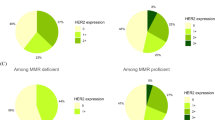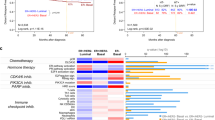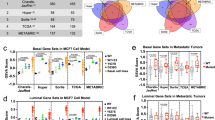Abstract
High-grade serous ovarian carcinoma (HGSOC) and basal-like breast cancer (BLBC) share many features including TP53 mutations, genomic instability and poor prognosis. We recently reported that Elafin is overexpressed by HGSOC and is associated with poor overall survival. Here, we confirm that Elafin overexpression is associated with shorter survival in 1000 HGSOC patients. Elafin confers a proliferative advantage to tumor cells through the activation of the MAP kinase pathway. This mitogenic effect can be neutralized by RNA interference, specific antibodies and a MEK inhibitor. Elafin expression in patient-derived samples was also associated with chemoresistance and strongly correlates with bcl-xL expression. We extended these findings into the examination of 1100 primary breast tumors and six breast cancer cell lines. We observed that Elafin is overexpressed and secreted specifically by BLBC tumors and cell lines, leading to a similar mitogenic effect through activation of the MAP kinase pathway. Here too, Elafin overexpression is associated with poor overall survival, suggesting that it may serve as a biomarker and therapeutic target in this setting.
This is a preview of subscription content, access via your institution
Access options
Subscribe to this journal
Receive 50 print issues and online access
$259.00 per year
only $5.18 per issue
Buy this article
- Purchase on Springer Link
- Instant access to full article PDF
Prices may be subject to local taxes which are calculated during checkout







Similar content being viewed by others
References
Mavaddat N, Barrowdale D, Andrulis IL, Domchek SM, Eccles D, Nevanlinna H et al. Pathology of breast and ovarian cancers among BRCA1 and BRCA2 mutation carriers: results from the Consortium of Investigators of Modifiers of BRCA1/2 (CIMBA). Cancer Epidemiol Biomarkers Prev 2012; 21: 134–147.
Rakha EA, Reis-Filho JS, Ellis IO . Basal-like breast cancer: a critical review. J Clin Oncol 2008; 26: 2568–2581.
Manie E, Vincent-Salomon A, Lehmann-Che J, Pierron G, Turpin E, Warcoin M et al. High frequency of TP53 mutation in BRCA1 and sporadic basal-like carcinomas but not in BRCA1 luminal breast tumors. Cancer Res 2009; 69: 663–671.
Bell D, Berchuck A, Birrer M, Chien J, Cramer D, Dao F et al. TCGA: Integrated genomic analyses of ovarian carcinoma. Nature 2011; 474: 609–615.
Kwei KA, Kung Y, Salari K, Holcomb IN, Pollack JR . Genomic instability in breast cancer: pathogenesis and clinical implications. Mol Oncol 2010; 4: 255–266.
Koboldt DC, Fulton RS, McLellan MD, Schmidt H, Kalicki-Veizer J, McMichael JF et al. Comprehensive molecular portraits of human breast tumours. Nature 2012; 490: 61–70.
Wang ZC, Birkbak NJ, Culhane AC, Drapkin R, Fatima A, Tian R et al. Profiles of genomic instability in high-grade serous ovarian cancer predict treatment outcome. Clin Cancer Res 2012; 18: 5806–5815.
Williams SE, Brown TI, Roghanian A, Sallenave JM . SLPI and elafin: one glove, many fingers. Clin Sci (Lond) 2006; 110: 21–35.
Pfundt R, van Ruissen F, van Vlijmen-Willems IM, Alkemade HA, Zeeuwen PL, Jap PH et al. Constitutive and inducible expression of SKALP/elafin provides anti-elastase defense in human epithelia. The J Clin Invest 1996; 98: 1389–1399.
Ghosh M, Shen Z, Fahey JV, Cu-Uvin S, Mayer K, Wira CR . Trappin-2/Elafin: a novel innate anti-human immunodeficiency virus-1 molecule of the human female reproductive tract. Immunology 2010; 129: 207–219.
Kulasingam V, Diamandis EP . Proteomics analysis of conditioned media from three breast cancer cell lines: a mine for biomarkers and therapeutic targets. Mol Cell Proteomics 2007; 6: 1997–2011.
Paczesny S, Braun TM, Levine JE, Hogan J, Crawford J, Coffing B et al. Elafin is a biomarker of graft-versus-host disease of the skin. Sci Translational Med 2010; 2: 13ra2.
Levine JE, Logan BR, Wu J, Alousi AM, Bolanos-Meade J, Ferrara JL et al. Acute graft-versus-host disease biomarkers measured during therapy can predict treatment outcomes: a Blood and Marrow Transplant Clinical Trials Network study. Blood 2012; 119: 3854–3860.
Drapkin R, von Horsten HH, Lin Y, Mok SC, Crum CP, Welch WR et al. Human epididymis protein 4 (HE4) is a secreted glycoprotein that is overexpressed by serous and endometrioid ovarian carcinomas. Cancer Res 2005; 65: 2162–2169.
Bouchard D, Morisset D, Bourbonnais Y, Tremblay GM . Proteins with whey-acidic-protein motifs and cancer. Lancet Oncol 2006; 7: 167–174.
Hellstrom I, Raycraft J, Hayden-Ledbetter M, Ledbetter JA, Schummer M, McIntosh M et al. The HE4 (WFDC2) protein is a biomarker for ovarian carcinoma. Cancer Res 2003; 63: 3695–3700.
Moore RG, McMeekin DS, Brown AK, DiSilvestro P, Miller MC, Allard WJ et al. A novel multiple marker bioassay utilizing HE4 and CA125 for the prediction of ovarian cancer in patients with a pelvic mass. Gynecol Oncol 2009; 112: 40–46.
Clauss A, Lilja H, Lundwall A . A locus on human chromosome 20 contains several genes expressing protease inhibitor domains with homology to whey acidic protein. Biochem J 2002; 368 (Pt 1): 233–242.
Lundwall A, Clauss A . Identification of a novel protease inhibitor gene that is highly expressed in the prostate. Biochem biophysi Research Commun 2002; 290: 452–456.
McLendon R, Friedman A, Bigner D, Van Meir EG, Brat DJ, Mastrogianakis GM et al. Comprehensive genomic characterization defines human glioblastoma genes and core pathways. Nature 2008; 455: 1061–1068.
Wei H, Hellstrom KE, Hellstrom I . Elafin selectively regulates the sensitivity of ovarian cancer cells to genotoxic drug-induced apoptosis. Gynecol Oncol 2012; 125: 727–733.
Clauss A, Ng V, Liu J, Piao H, Russo M, Vena N et al. Overexpression of elafin in ovarian carcinoma is driven by genomic gains and activation of the nuclear factor kappaB pathway and is associated with poor overall survival. Neoplasia 2010; 12: 161–172.
Gyorffy B, Lanczky A, Szallasi Z . Implementing an online tool for genome-wide validation of survival-associated biomarkers in ovarian-cancer using microarray data from 1287 patients. Endocr Relat Cancer 2012; 19: 197–208.
Verrier T, Solhonne B, Sallenave JM, Garcia-Verdugo I . The WAP protein Trappin-2/Elafin: a handyman in the regulation of inflammatory and immune responses. Int J Biochem Cell Biol 2012; 44: 1377–1380.
Doucet A, Bouchard D, Janelle MF, Bellemare A, Gagne S, Tremblay GM et al. Characterization of human pre-elafin mutants: full antipeptidase activity is essential to preserve lung tissue integrity in experimental emphysema. Biochem J 2007; 405: 455–463.
Askenazi M, Li S, Singh S, Marto JA . Pathway Palette: a rich internet application for peptide-, protein- and network-oriented analysis of MS data. Proteomics 2010; 10: 1880–1885.
Hodge C, Liao J, Stofega M, Guan K, Carter-Su C, Schwartz J . Growth hormone stimulates phosphorylation and activation of elk-1 and expression of c-fos, egr-1, and junB through activation of extracellular signal-regulated kinases 1 and 2. J Biol Chem 1998; 273: 31327–31336.
Tibes R, Qiu Y, Lu Y, Hennessy B, Andreeff M, Mills GB et al. Reverse phase protein array: validation of a novel proteomic technology and utility for analysis of primary leukemia specimens and hematopoietic stem cells. Mol Cancer Ther 2006; 5: 2512–2521.
Hennessy BT, Lu Y, Gonzalez-Angulo AM, Carey MS, Myhre S, Ju Z et al. A Technical Assessment of the Utility of Reverse Phase Protein Arrays for the Study of the Functional Proteome in Non-microdissected Human Breast Cancers. Clin Proteomics 2010; 6: 129–151.
Williams J, Lucas PC, Griffith KA, Choi M, Fogoros S, Hu YY et al. Expression of Bcl-xL in ovarian carcinoma is associated with chemoresistance and recurrent disease. Gynecol Oncol 2005; 96: 287–295.
Jinawath N, Vasoontara C, Jinawath A, Fang X, Zhao K, Yap KL et al. Oncoproteomic analysis reveals co-upregulation of RELA and STAT5 in carboplatin resistant ovarian carcinoma. PloS One 2010; 5: e11198.
Etemadmoghadam D, deFazio A, Beroukhim R, Mermel C, George J, Getz G et al. Integrated genome-wide DNA copy number and expression analysis identifies distinct mechanisms of primary chemoresistance in ovarian carcinomas. Clin Cancer Res 2009; 15: 1417–1427.
Huper G, Marks JR . Isogenic normal basal and luminal mammary epithelial isolated by a novel method show a differential response to ionizing radiation. Cancer Res 2007; 67: 2990–3001.
Pazaiti A, Fentiman IS . Basal phenotype breast cancer: implications for treatment and prognosis. Womens Health (Lond Engl) 2011; 7: 181–202.
Wang Y, Klijn JG, Zhang Y, Sieuwerts AM, Look MP, Yang F et al. Gene-expression profiles to predict distant metastasis of lymph-node-negative primary breast cancer. Lancet 2005; 365: 671–679.
Richardson AL, Wang ZC, De Nicolo A, Lu X, Brown M, Miron A et al. X chromosomal abnormalities in basal-like human breast cancer. Cancer Cell 2006; 9: 121–132.
Li Q, Eklund AC, Juul N, Haibe-Kains B, Workman CT, Richardson AL et al. Minimising immunohistochemical false negative ER classification using a complementary 23 gene expression signature of ER status. PLoS One 2010; 5: e15031.
Pawitan Y, Bjohle J, Amler L, Borg AL, Egyhazi S, Hall P et al. Gene expression profiling spares early breast cancer patients from adjuvant therapy: derived and validated in two population-based cohorts. Breast Cancer Res 2005; 7: R953–R964.
Desmedt C, Piette F, Loi S, Wang Y, Lallemand F, Haibe-Kains B et al. Strong time dependence of the 76-gene prognostic signature for node-negative breast cancer patients in the TRANSBIG multicenter independent validation series. Clin Cancer Res 2007; 13: 3207–3214.
Schmidt M, Bohm D, von Torne C, Steiner E, Puhl A, Pilch H et al. The humoral immune system has a key prognostic impact in node-negative breast cancer. Cancer Res 2008; 68: 5405–5413.
Bittner M Expression project for Oncology (expO). [cited; Available from www.intgen.org/expo/].
Haibe-Kains B, Desmedt C, Loi S, Culhane AC, Bontempi G, Quackenbush J et al. A three-gene model to robustly identify breast cancer molecular subtypes. J Natl Cancer Inst 2012; 104: 311–325.
Gyorffy B, Lanczky A, Eklund AC, Denkert C, Budczies J, Li Q et al. An online survival analysis tool to rapidly assess the effect of 22,277 genes on breast cancer prognosis using microarray data of 1,809 patients. Breast Cancer Res Treat 2010; 123: 725–731.
Neve RM, Chin K, Fridlyand J, Yeh J, Baehner FL, Fevr T et al. A collection of breast cancer cell lines for the study of functionally distinct cancer subtypes. Cancer Cell 2006; 10: 515–527.
Zhang M, Zou Z, Maass N, Sager R . Differential expression of elafin in human normal mammary epithelial cells and carcinomas is regulated at the transcriptional level. Cancer Res 1995; 55: 2537–2541.
Aung G, Niyonsaba F, Ushio H, Ikeda S, Okumura K, Ogawa H . Elafin and secretory leukocyte protease inhibitor stimulate the production of cytokines and chemokines by human keratinocytes via MAPK/ERK and NF-kappaB activation. J Dermatol Sci 2011; 63: 128–131.
Davis RJ . Signal transduction by the JNK group of MAP kinases. Cell 2000; 103: 239–252.
Morton S, Davis RJ, Cohen P . Signalling pathways involved in multisite phosphorylation of the transcription factor ATF-2. FEBS Lett 2004; 572: 177–183.
Dent R, Trudeau M, Pritchard KI, Hanna WM, Kahn HK, Sawka CA et al. Triple-negative breast cancer: clinical features and patterns of recurrence. Clin Cancer Res 2007; 13 (15 Pt 1): 4429–4434.
Jemal A, Siegel R, Xu J, Ward E . Cancer statistics, 2010. CA Cancer J Clin 2010; 60: 277–300.
Saidi A, Javerzat S, Bellahcene A, De Vos J, Bello L, Castronovo V et al. Experimental anti-angiogenesis causes upregulation of genes associated with poor survival in glioblastoma. Int J Cancer 2008; 122: 2187–2198.
Caruso JA, Hunt KK, Keyomarsi K . The neutrophil elastase inhibitor elafin triggers rb-mediated growth arrest and caspase-dependent apoptosis in breast cancer. Cancer Res 2010; 70: 7125–7136.
Yokota T, Bui T, Liu Y, Yi M, Hunt KK, Keyomarsi K . Differential regulation of elafin in normal and tumor-derived mammary epithelial cells is mediated by CCAAT/enhancer binding protein beta. Cancer Res 2007; 67: 11272–11283.
Levanon K, Crum C, Drapkin R . New insights into the pathogenesis of serous ovarian cancer and its clinical impact. J Clin Oncol 2008; 26: 5284–5293.
Karst AM, Drapkin R . Ovarian cancer pathogenesis: a model in evolution. J Oncol 2010; 2010: 932371.
Karst AM, Levanon K, Drapkin R . Modeling high-grade serous ovarian carcinogenesis from the fallopian tube. Proc Natl Acad Sci U S A 2011; 108 (18): 7547–7552.
Levanon K, Ng V, Piao HY, Zhang Y, Chang MC, Roh MH et al. Primary ex vivo cultures of human fallopian tube epithelium as a model for serous ovarian carcinogenesis. Oncogene 2010; 29: 1103–1113.
Shaw L, Wiedow O . Therapeutic potential of human elafin. Biochem Soc Trans 2011; 39: 1450–1454.
Ficarro SB, Zhang Y, Carrasco-Alfonso MJ, Garg B, Adelmant G, Webber JT et al. Online nanoflow multidimensional fractionation for high efficiency phosphopeptide analysis. Mol Cell Proteomics 2011; 10: O111 011064.
Vermeer PD, Bell M, Lee K, Vermeer DW, Wieking BG, Bilal E et al. ErbB2, EphrinB1, Src kinase and PTPN13 signaling complex regulates MAP kinase signaling in human cancers. PLoS One 2012; 7: e30447.
Gautier L, Cope L, Bolstad BM, Irizarry RA . affy—analysis of Affymetrix GeneChip data at the probe level. Bioinformatics 2004; 20: 307–315.
Wickham H . ggplot2: elegant graphics for data analysis. Springer, New York, 2009.
Saldanha AJ . Java Treeview—extensible visualization of microarray data. Bioinformatics 2004; 20: 3246–3248.
Acknowledgements
The authors thank Dr Michelle Hirsch for critical review of the manuscript, Laura Selfors of biocomputing analyzes of the RPPA data, and members of the Drapkin laboratory for fruitful discussions. This work was supported by the NIH/NCI SPORE in OC P50-CA105009 (RD), U01 CA-152990 (RD), R21 CA-156021 (RD); NIH/NINDS P01 NS047572 (JM), the Honorable Tina Brozman ‘Tina’s Wish’ Foundation (JM, RD), the Dr Miriam and Sheldon G. Adelson Medical Research Foundation (GBM and RD), The Robert and Debra First Fund (RD), The Gamel Family Fund (RD), the Ovarian Cancer Research Fund (RD), The Madeline Franchi Ovations for the Cure Fund (AC), the Mary Kay Foundation (RD), the Sandy Rollman Ovarian Cancer Foundation (RD), the Dana-Farber Cancer Institute (DFCI) Strategic Initiative (JM), the Executive Council of the Susan Smith Center for Women’s Cancers at the DFCI, the Triple Negative Breast Cancer Foundation (SG), and the New Jersey Commission on Cancer Research (SG). SILG is a recipient of grants from Arthur Sachs/Fulbright/Harvard, La Fondation Philippe and La Fondation de France—‘Recherche clinique en cancérologie – Aide à la mobilité des chercheurs’.
Author information
Authors and Affiliations
Corresponding author
Ethics declarations
Competing interests
The authors declare no conflict of interest.
Additional information
Supplementary Information accompanies this paper on the Oncogene website
Rights and permissions
About this article
Cite this article
Labidi-Galy, S., Clauss, A., Ng, V. et al. Elafin drives poor outcome in high-grade serous ovarian cancers and basal-like breast tumors. Oncogene 34, 373–383 (2015). https://doi.org/10.1038/onc.2013.562
Received:
Revised:
Accepted:
Published:
Issue Date:
DOI: https://doi.org/10.1038/onc.2013.562
Keywords
This article is cited by
-
Development and validation of a disulfidptosis and disulfide metabolism-related risk index for predicting prognosis in lung adenocarcinoma
Cancer Cell International (2024)
-
Multi-omics data integration reveals the molecular network of dysregulation IQGAP2-mTOR promotes cell proliferation
Human Cell (2023)
-
A bioinformatic analysis of WFDC2 (HE4) expression in high grade serous ovarian cancer reveals tumor-specific changes in metabolic and extracellular matrix gene expression
Medical Oncology (2022)
-
Model constructions of chemosensitivity and prognosis of high grade serous ovarian cancer based on evaluation of immune microenvironment and immune response
Cancer Cell International (2021)
-
Elafin promotes tumour metastasis and attenuates the anti-metastatic effects of erlotinib via binding to EGFR in hepatocellular carcinoma
Journal of Experimental & Clinical Cancer Research (2021)



